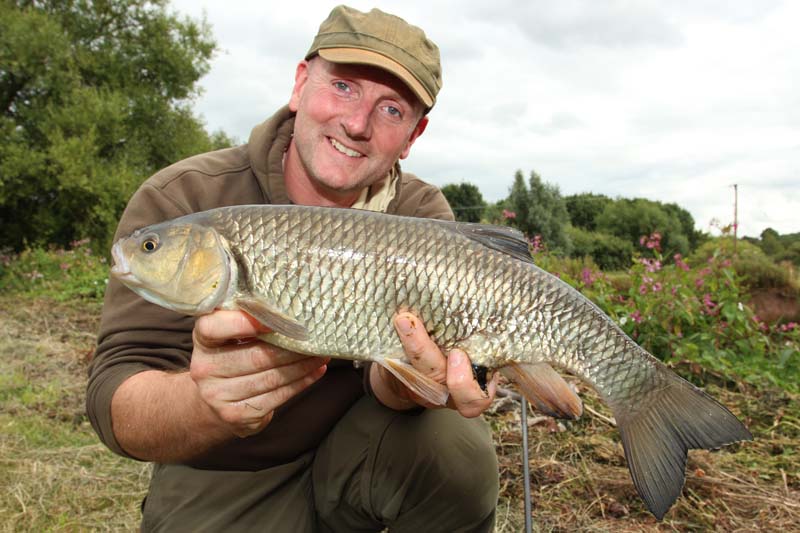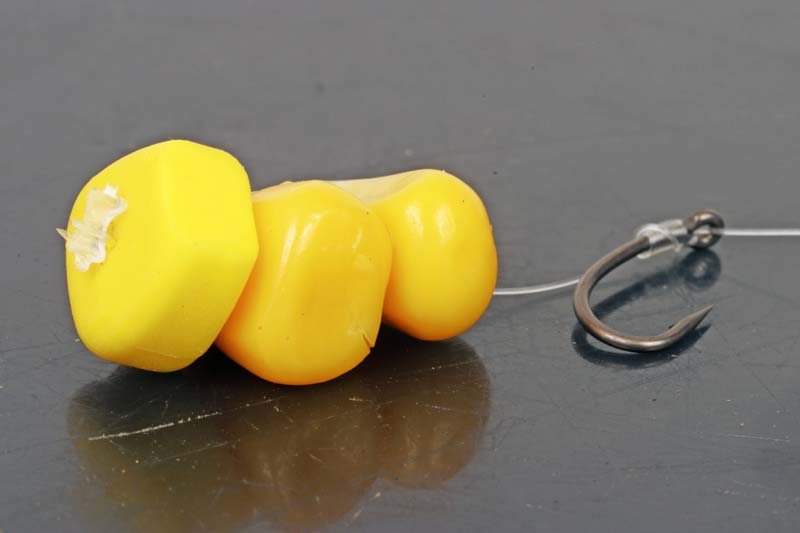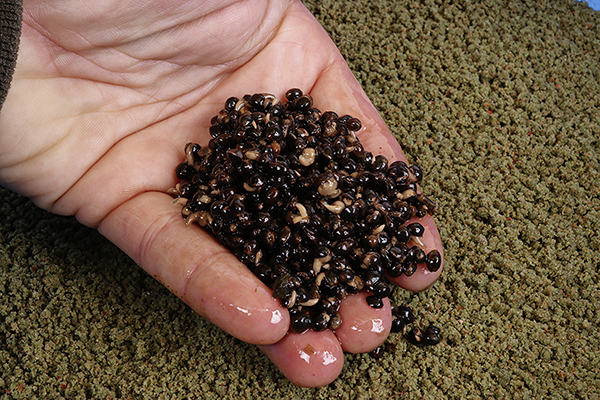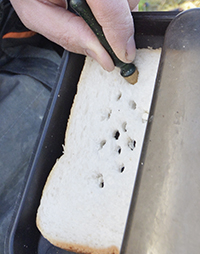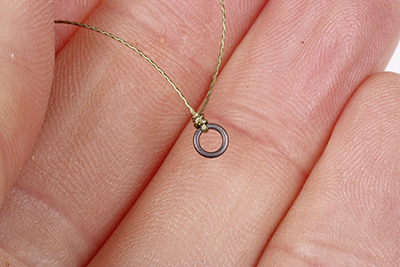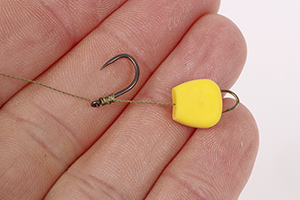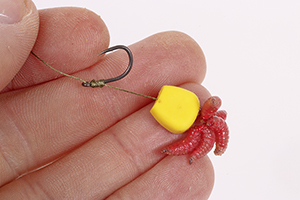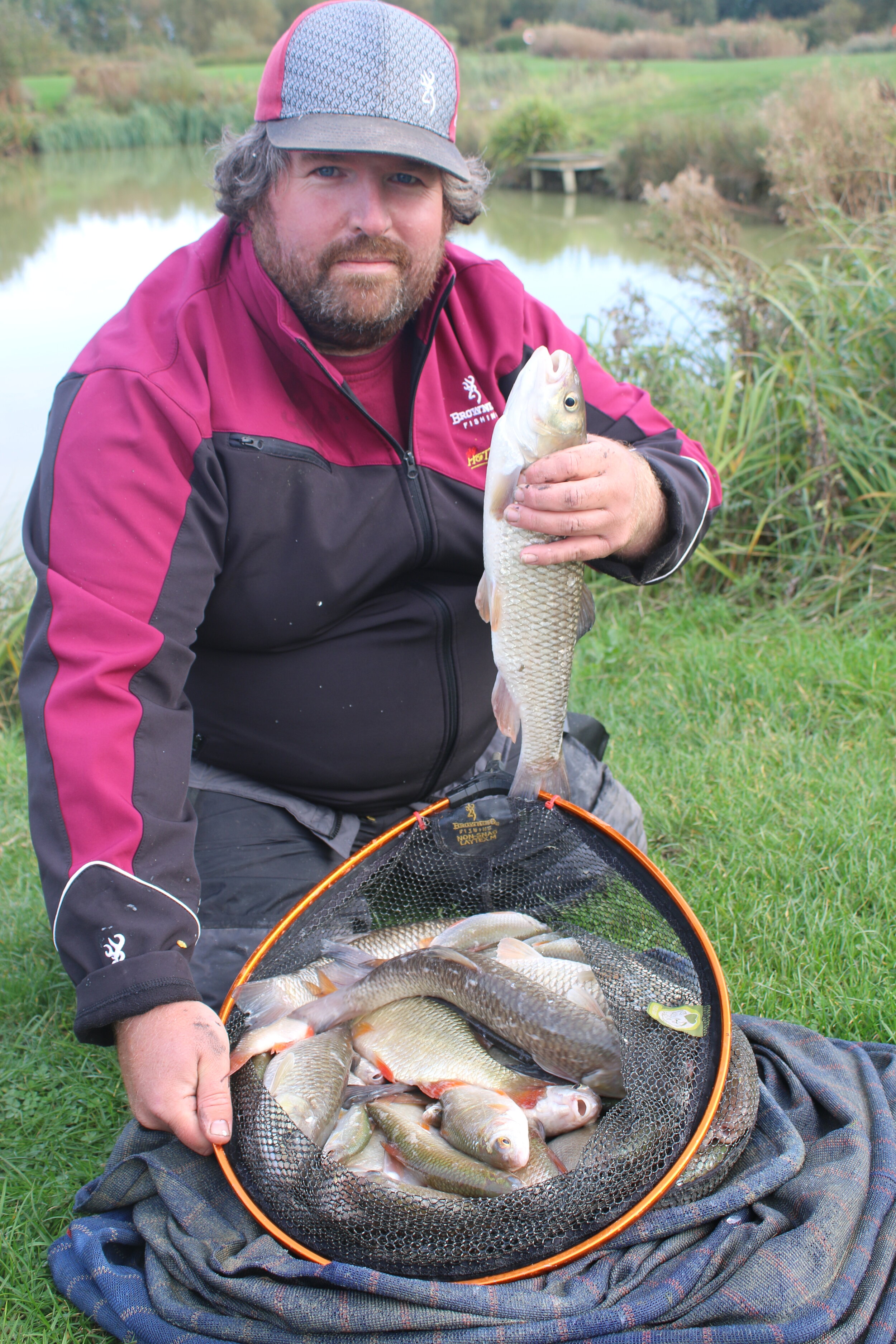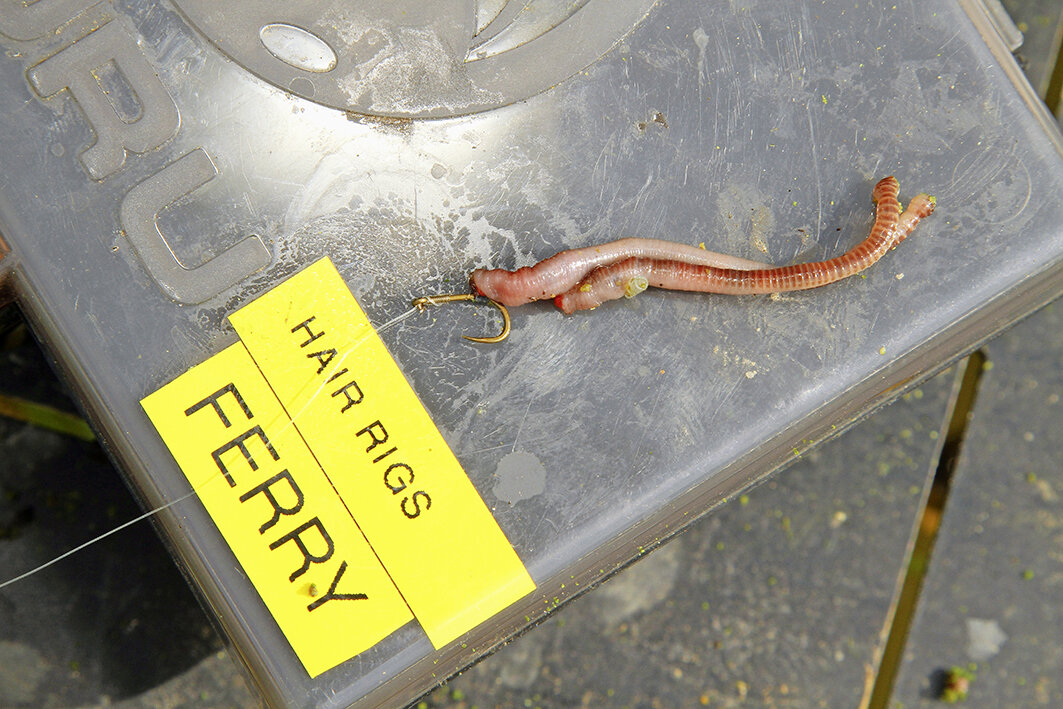Six steps to a big autumn stripey
When it comes to catching predators by design, watercraft is king.
Thinking about what you’re doing and, more importantly, what the fish are doing, will not only save you precious time, but also deliver the kind of sport you’re after.
One angler who understands watercraft only too well is Fox Rage expert Gary Edmonds. Gary has been lure fishing for decades, and seems to have a sixth sense for tuning in to what predators are getting up to.
“There are no hard and fast rules to it,” smiles Gary as he steps on to the banks of his local Rib Valley Lakes, ready to cast for perch. “But in general, if you apply the right thinking, you can usually work out where they’ll be – and from there you can work out what it’s going to take to catch them.”
1) Timing
Get out of bed early for the best chance of catching perch, which will usually be very active just as the sun rises. “It can be hard work, but it’s usually worth it,” Gary explains.
“Depending on conditions, you’ll usually get a good hour or two of activity.” This early morning action is based on light levels. The predators make use of the cover of shade and this, combined with their superior eyesight, gives them an advantage over prey fish.
“The same is true of dusk but,
in my experience, it’s first light when you really have the best chance, especially with perch,” says Gary.
2) Light
Light, and the amount of it, has a big impact on the activity levels of predators. But that’s not just confined to first and last light.
“Realistically, the best days are dull, with a good ripple on the water which breaks up the light under the surface even further,” Gary explains.
“Even when the sun is up high and bright overhead, some of the worst conditions, you can still use light levels to your advantage.
“I look for a number of things. First off, natural shade from trees and bushes always works well. That contrast between the dark and bright water areas will attract predators which will hang in the cover of the shadows. Areas such as the margins of islands that are in shade are always great to try if you can reach them.”
3) lake topography
The underwater make-up of a lake has a huge impact on where you will find your target species.
It’s easy to just think of the bottom of the water in front of you as sloping off and then being fairly uniform, but that is hardly ever the case.
“It’s crucial to get a good idea of what is happening in front of you so you can fish for the predators in the most likely spots and make your fishing more likely to result in bites,” Says Gary.
“If you don’t know a water, it’s worth taking the time to cast your lure around and count it down on a tight line, waiting for it to touch bottom, at which point the line will go slack. You’re looking for variations in the time it takes for your lure to reach bottom. That will indicate changes of depth.”
These changes of depth are the areas that Gary will spend his time fishing, be that a steep drop off, a hole, a bar in open water, or in a fairly uniform area, even just a slight dip – all can be enough to hold fish, especially perch.
“Predators will be looking for areas where they can sit and gain a tactical advantage over their prey,” says Gary, casting out his lure.
“That could just be light cover as they sit lower down on a slope, or lurk on the far side of a bar.”
4) Temperatures
“In the winter, as the temperature drops the fish will be slow but still need to feed, although this can be in small windows of time during the day,” explains Gary,
“They will also look to have a more stable temperature that is less affected by sudden drops caused by overnight frosts and the like. They look to go to deeper water which is more temperature-stable, and that’s where you will most likely find them.
“On days when the temperature lifts, prey fish will move to shallower water which will warm up more quickly, and the predators will follow. On those warmer winter days I will quite often target the slightly deeper water behind shallows where I can see prey fish. This can result in some great sport.”
5) Man-made areas
Although they are always talked about in terms of fish-holding spots, man-made structures such as pontoons, walls or anywhere that will give fish cover will attract prey and therefore predators, and so they are definitely worth covering.
“If the water you’re on is fished a lot these will normally be the spots that get the most pressure, as they are the most obvious,” says Gary. “But they are still worth your attention. Structure in depth of water is what you really want. Something offering shade and cover ticks a lot of boxes with all fish – all you need to do is approach it differently to other anglers, whether that’s getting there earlier, fishing it later, using different sized or actioned lures or trying different techniques like weedless deadsticking.”
“Man-made structures really come into their own on what appear to be uniform, barren waters, such as canals and drains.
“If you have no discernible features and then suddenly find an outlet pipe or even a shopping trolley in the water, there will normally be fish around it.”
6) Techniques
In cold weather, cold water will result in cold fish that are less active, so you need to adapt to catch them. “One of the best techniques for lethargic fish is drop shotting,” explains Gary.
“In these conditions, working a jig slowly enough to get them to bite properly can be very difficult, but if you know where the fish are, a drop shot approach will allow you to present a lure effectively in the same place for as long as you like.
“This will get their attention, hold it and tease them into striking, especially if you have a shoal of perch in front of you. They will become competitive, and it puts them under pressure to hit a free meal before another fish does.”
Chub Fishing Baits | Best baits for big chub
We asked bait expert Paul Garner what his best baits to go chub fishing with were and he came back with five amazing chub baits that will make sure you land your biggest ever chub on your next session.
The scorching weather of the past few weeks has had a big impact on my river fishing so far this season.
For more great tips from top anglers head to this year’s The Big One Show
With barbel off the menu, I have spent some enjoyable evenings stalking chub on my local rivers instead. The low, clear water conditions have been perfect for this, with the dark shadows lurking under the overhanging branches of bankside trees giving away the presence of my quarry.
Location is rarely a problem with chub – you know they are never going to be far away from cover at any time of the year, and a good flow will attract them too, even if the water is only knee-deep. Persuading them to take a bait can be a different proposition, though, especially if they have been fished for, as their superb eyesight and uncanny ability to spot anything out of the ordinary can make them frustratingly difficult to catch.
With time, and a steady supply of maggots or casters, you can overcome this natural caution and often catch most of the fish in a shoal, but I prefer to roam the river, looking for fish and making just a cast or two in any likely-looking spots before moving on to pastures new.
Fishing like this, especially if you can follow the path of the bait and the reaction of the fish, can teach you a lot about the behaviour of the wily chub in your local river.
Choice of bait is important, and although I will normally only carry one or two types with me at any one time, there are five that stand out as the best for summer chubbing.
SLUGS
Not for the squeamish, but by far the most effective chub bait that I have ever used, slugs elicit an instant reaction from chub that has to be seen to believed.
The loud ‘plop’ of a slug hitting the water will attract any chub in the swim and within seconds those white rubbery lips will engulf a freelined bait. If you don’t get a bite on a slug then you can be pretty sure that there are no chub in the swim!
While my garden is full of slugs in the spring, hot weather can make them difficult to find, just when you need them most.
Look in any dark corners of the garden, especially first thing in the morning. Compost containers are often home to loads of slugs and are the ideal places fom which to collect them. There are several different species, and the chub love them all! Store your slugs in a cool, dark spot and they will last for several days.
WORMS
When I find it impossible to collect slugs my second choice, although it can be hit-and-miss, is worms. You won’t find a worm that is too big for a chub, so go for the largest you can find, as this will add casting weight.
The bigger the worm, the more it can resist the attentions of small fish. Just as with slugs, you are likely to get a bite on the first or second cast as the chub home in on the splash. If no reaction is forthcoming it’s best to move to a new spot and try again.
Hooked once through the ‘saddle’, worms will last for several casts if they aren’t gobbled up first. Although not as dense as slugs, worms can still be lobbed a reasonable distance without any additional weight needing to be added.
LUNCHEON MEAT
I always keep a couple of tins of meat in the car. Although not the most effective chub bait, a cube of meat can save the day when other baits are hard to come by. I treat meat just as I do slugs, hooking a large cube on to a size 8 hook and freelining it into any likely-looking spot. One benefit of meat is that its light colour is very easy to follow as it slowly sinks and drifts downstream.
Often, the bait will simply disappear as a chub swallows it.
BREAD CRUST
On larger rivers it can be difficult to spot chub, especially if they are holding station in mid-river. In this situation you can still freeline a bait and simply watch the line for bites, but often a different approach is more effective.
On hot, windless evenings chub will often take emerging insects off the surface and we can make use of this behaviour to catch them. The crusts of a fresh loaf make the ideal bait, pulled into chunks and allowed to drift downstream. Pay particular attention to crease lines, where chub are likely to hold station.
Follow the crusts downstream until you spot the tell-tale splashes of chub picking them off. Once the chub are feeding confidently like this the hookbait is likely to be taken straight away.
TINY LURES
For sheer fun and excitement, few methods beat light lure fishing for chub. A splashy lure fished on or just beneath the surface will often bring a response. Try fishing really shallow swims where the broken water gives way to a steady glide. Often chub will be here feeding on minnows and other small fish.
Alternatively, try using more imitative lures – grasshoppers, crayfish and tiny fish patterns – that can be mounted on a 3g jig head and bounced across the bottom of shallow swims.
Expect the unexpected, and don’t be surprised if this tactic catches other species too.
Five amazing baits for summer bream
Want to land a big net of specimen bream this summer? Then check out these great bait tips for bream from bait expert Paul Garner as he has put together the ultimate list of bream baits to help you catch more now.
For more great tips from top anglers head to this year’s The Big One Show
Every summer I try to put together a good catch of bream.
This could come from a river or a stillwater, as both types of venue can contain shoals of slabs averaging 5lb and upwards.
My tactics are simple, but effective. The Method feeder is my first choice, loaded with a groundbait mix that won’t break the bank.
A lot of rubbish gets talked about how much bait you need to catch bream. Sure, a shoal can number dozens, if not hundreds, of fish, but remember – you are trying to catch them, not feed them! My experience is that heavy baiting for bream can be counter-productive.
If the fish are following a patrol route then no amount of bait will persuade them to stop. Introduce too much and they will leave most of it, including your hookbait.
A couple of kilos of bait is more than adequate for a day or night session. The bulk of this will be groundbait, with a tin of sweetcorn and some pellets and mini-boilies thrown in for good measure. If I have some frozen maggots in the freezer they will go in too, but they are just the cherry on the cake and not essential.
CHEAP GROUNDBAIT MIXES
Bream do love fishmeal groundbaits, and a mix that contains plenty of crushed pellets will certainly do the trick.
It’s surprising how little fishmeal is needed in the mix to have an effect, though, so to cut costs I will use a 50-50 combination of groundbait and brown crumb, to bulk out the bait. Remember, though, that brown crumb does not bind particularly well, so this could well affect how much feed the groundbait can hold.
I use soaked flaked maize a lot. This resembles cornflakes in its dry state, because that is essentially what it is! When soaked it swells up and emits a milky haze with soft flakes that bream (and carp) really like.
I use molasses to flavour and sweeten the groundbait – I find it to be most effective for bream, and it’s cheap. You can buy it by the litre from animal feed shops.
Sweetcorn
Bream love corn. Its yellow colour and salty taste make it easy for them to locate and they will spend a lot of time eating every grain. This makes it a top hookbait too and I normally use two or three grains on a hair to make the hookbait stand out. Because this is a relatively soft bait, look for grains that are fully intact. Try combining two pieces of real corn with a buoyant flake bait to produce a brilliant wafter.
Mini-boilies
If I am night fishing then 12mm boilies will often be my hookbait of choice, simply because they are long-lasting and I can have total confidence that they will still be there come morning. For bream up to about 8lb I use a single 12mm bait, but for bigger specimens I find two 12mm baits brings more bites. Try a sweet flavour, such as Strawberry Crush.
Dead maggots
Live maggots can attract too much attention from small fish, even though they are a brilliant day-time bait. Switching to dead maggots both in your feed and on the hook can avoid this problem, as their lack of movement doesn’t attract as many small nuisance tiddlers. Try using a bunch of four maggots on a size 14 hook for best results.
Worms
Worms can be problematic if you are on a venue with a lot of small fish, but on a
low-stocked pit they can be very effective. Try to get hold of some small lobworms – no more than 4ins long. I like to hair-rig these, adding a piece of buoyant corn to not only give the bait some buoyancy, but also to act as a giant bait stop.
Pellets
Bream love pellets, especially high-oil halibut pellets, and two 10mm baits hair-rigged in tandem have caught me a lot of big bream. You can buy ready-drilled baits that are very easy to rig, but the hole can be a little too large for a normal bait stop. Try using a Quick Stop, or add a tiny square of elastic band before the stop.
Spend less and catch more with this method mix!
Want to catch more carp while fishing? then take a look at this amazing carp fishing method mix from Angling Times columnist and Nash backed Paul Garner. We asked Paul to give us his best carp fishing bait on a budget and he came back with this golden piece of information.
Rather than use a Method mix that breaks down quickly, I much prefer a slower release of bait from the open frame of the flatbed feeder.
This ensures that the the bait on the feeder will remain the focus for the carp even when their frantic grubbing around on the bottom, complete with waving tails, is washing the pellets all over the swim.
To get this slower release effect is simple – I mix a small amount of groundbait in with the soaked pellets, as here...
1) Cover a pint of 4mm coarse fishery pellets with water and let them stand for four minutes to absorb some of the water.
Pour off the excess water and allow the pellets to stand for a few minutes more until they are soft all the way through.
Add just a sprinkling of Method groundbait to the pellets and mix well so that the dry groundbait evenly coats the pellets.
Use a Method mould to firmly press the pellets on to the feeder in the usual manner.
Leave the hookbait just outside the feeder so that it is not obstructed by the pellet feed.
10 of the best tench fishing tips and baits
Spring is here and so are the tench! We've decided to compile together 10 of the best tench fishing tips and ait for you to use on your spring and summer campaigns for this great species. To help us put together these great tench fishing baits we asked bait expert Paul Garner to give us some of his favourite tench baits.
From floatfishing in the margins, to long-range feeder fishing, the tench angler has to master many different methods, and learn how to get the best from the available baits.
My tench fishing evolves over the coming weeks as the fish change their behaviour, but there are some tactics that come into play each season for me and which have stood the test of time. Let me share them with you...
1) shellfish maggots
Maggots often figure very highly in my tench fishing.
Being easier to store than casters, maggots are a convenient choice that have caught me tench on every venue where I have tried them. I always use the freshest and cleanest maggots that I can buy. Every few days I change the maize flour that I store them in, as this does become sour, even if the maggots sweat.
There is one additive that I always use on my maggots when tench fishing, and that is Shellfish Sense Appeal. Just a few drops of this smelly shellfish extract added to a pint of maggots will have a big impact on my catches, and I never leave home without it.
2) Yellow pop-ups
When tench are just getting going in the spring, a highly visible bait often scores really well.
I noticed a few years ago that carp anglers tend to catch tench at this time of year on their chod rigs, especially when using small yellow baits. Following suit with a scaled-down approach, I found myself catching loads of tench on 10mm pop-ups fished on a mini chod rig.
I think that any tench that is cruising past can spot the yellow hookbait very easily, and more often than not will eat it. Don’t expect this tactic to last for very long, though. For some reason it loses its effectiveness by the middle of May.
3) hemp as a holding bait
Hemp is a great bait for attracting and holding tench, but I am not convinced that they actually eat much of it.
Underwater filming has shown that tench often pick up hemp but then blow it back out again, rather than swallowing it.
This has certainly influenced how much hemp I introduce, and now I rarely use more than a pint per day. I like to introduce this on a little and often basis, keeping that lovely nutty smell topped up, but not introducing too much bait.
4) Cocktail Baits
You can often get extra bites by combining two tench baits on the hook, especially if you have both baits in your loosefeed.
Try a combination of worm and caster, or maggot and corn, to produce a bait with some movement and more bulk than either bait on its own.
5) Sweetcorn
At one time sweetcorn was talked about in hushed tones, so effective was it as a tench bait, but in recent years it has certainly fallen out of favour with many tench anglers.
This is a shame, as it is still a fantastic bait and if it hasn’t been used heavily on a venue it will often work really well. Carp anglers often introduce lots of corn in their spod mixes, yet never use it on the hook, so they are effectively prebaiting for you!
I normally use two grains on the hook when floatfishing to create a nice visible bait. If you are legering, try a combination of one real and one fake piece of corn.
A small tin of corn is more than enough for a tench session. Try feeding six grains after every bite to keep the fish interested.
6) worm rigs
Worms can be quite difficult to fish with, especially if you are legering, as they have a tendency to work their way off the hook.
Overcome this by tying up a hair rig with a rubber caster and a Quickstop on the loop in the hair.
Push the Quicsktop through the worm leaving it fixed between the stop and the rubber caster, and it will not be able to escape. Use a short hair so that the worm is just below the bend of the hook.
The caster not only adds a small amount of buoyancy, but also stops the worm wrapping itself around the hook.
7) krill groundbait
Most anglers wouldn’t associate tench fishing with using groundbait, but a few years ago now I stumbled across a great combination that works very well in both a cage and Method feeder – and the tench love it!
I use a 50-50 mix of Dynamite Swim Stim Green groundbait and Krill Meal, and have found this to be supremely effective. Be careful not to over-wet this mix. It needs to be mixed slowly, so that the water is fully absorbed, until you are left with a fluffy texture that binds together quite well.
The Krill Meal is quite expensive, but fortunately you do not need a lot of this groundbait as I use it purely on the feeder – so half-a-bag is plenty for a day session.
8) Casters
Casters are a very effective tench bait. I use them on venues where small fish make using maggots difficult. This is not because they are second-best, but because maggots are easier to store both on and off the bank.
Try using two parts casters to one of hemp to keep tench grubbing away all day. There is no need to use real casters on the hook – although you can if you want to – but rubber casters are just as effective and far easier to use. Store casters in the fridge, in an open container so that they can breathe and stay slightly damp.
9) Fantastic plastic
Whether it is a bunch of rubber casters, a piece of fake corn, or a plastic pop-up boilie, tench will readily take artificial baits, and so often these can make the fishing so much easier.
I like to keep a range of different fake baits in my tackle box for occasions when small fish make using real baits difficult, or when I want to leave a bait out for several hours at a time.
Don’t worry that they have little natural smell – you can always try dipping plastic baits in additives, or fish them straight from the packet.
10) match the hatch
Very often tench can become harder to catch as the summer wears on. I think this is because their natural food become more abundant and they can pick and choose what they eat.
I tend to switch to smaller baits, such as maggots, by about June when the tench can be more picky.
It is also worth raking the swim lightly before fishing to disturb the natural insects on the bottom. This will draw in the tench and get them feeding hard.
Best bait for fishing in cold water
Are you struggling to catch in cold conditions? Well we got onto Guru backed Pemb Wrighting to tell us what bait is best to use when fishing in cold water. Take a look below at what he had to say.
Deadly bait
“Bread is absolutely brilliant in cold and clear water, and it is particularly effective when roach and skimmers are your target on lakes or canals.
“Its bright white colour means it stands out, and its lack of weight means it is easy for lethargic fish to suck up.
“Two loaves of bread are all you need for one session – the first has the crusts cut off and is put through a blender at home to create a fine loosefeed.
“The second is for the hookbait. I find that the cheapest loaf you can get your hands on is fine for the feed, using something a little tackier such as Warburton’s Toastie for the hook so that it stays on while shipping out and when waiting for a bite.”
Feeding regime
“A little-and-often feeding policy is usually adopted at this time of year, but when bread fishing is on the agenda things are a little different.
“I prefer to introduce a ball of bread the size of an orange at the start, and then only top up when the bites dry up.
“This concentrates the fish in one spot and they tend to remain over the top of the loosefeed until it has all been hoovered up.
“When bites slow down, introduce a nugget the size of a table tennis ball. The fish won’t be far away so not quite as much feed will kick-start things again.”
Delicate rigs
“Silver fish can be really finicky feeders, and if you use a float that isn’t dotted down enough or the tip is too thick you’ll miss an awful lot of bites.
“My favourite pattern for bread fishing is a Colmic Jolly. This has a rugby ball-shaped body, a carbon stem and a very fine tip. In water up to 4ft deep I will use a 4x12, stepping up to a 4x14 in anything deeper, or if it is windy.
“Light terminal tackle is also important and I use 0.11mm Guru N-Gauge mainline to a 0.08mm Guru Pure Fluorocarbon hooklength and a size 20 Guru Pole Special hook.
“These new hooks have the perfect shape for keeping 4mm punch on, and are extremely sharp, so you won’t lose any fish as you’re shipping in.”
Carp fishing with PVA bags
Using a PVA bag when carp fishing has become a very popular tactic for most carp angler's. However there are many ways in which PVA can be used when carp fishing below we will explain some of the best ways you can present your bait while fishing with PVA.
PVA (Poly-Vinyl Alcohol) is a water-soluble substance that can be made into solid sheets, tape and string, or woven to create a continuous mesh-type stocking.
Once in the water, the PVA will dissolve to leave a neat pile of freebies around your hook. Feed introduced in PVA traditionally needed to be completely dry, but ‘PVA-friendly’ oil-based liquids are now available, and won’t melt the PVA on the bank.
What to feed in PVA
The usual advice is to use only dry feed in PVA. However, ‘wet’ baits such as particles and nuts can be used if some dry groundbait, boilie base mix or salt is added.
Pellets are probably the most common filler for PVA bags and are first choice at this time of year.
Try using a brightly coloured pop-up boilie over the top of a small pile of PVA-introduced pellets and your chance of a carp will be good!
Another way to feed ‘wet’ baits is to coat the inside of a solid bag with an oil-based PVA-friendly liquid, then add the damp bait.
String
The traditional way to use PVA, but one that has gone out of fashion recently, PVA string is used to create a ‘stringer’. A number of baits – usually bottom bait boilies are threaded on to the string, which is then attached to your hook.
Rig foam
Although not made from PVA, these melting foam chunks have similar qualities and are used to prevent hookbaits from sinking into a soft, silty lake bed. Being buoyant, they hold the hook off the bottom before dissolving. They also help prevent tangles when using a long hair.
Solid bags
These can be filled with all manner of freebies, regardless of the size of bait used, just as long as the loosefeed is dry or any liquid is PVA-friendly. They should be prepared in advance for convenience, and pierced after tying to remove any trapped air.
Mesh bags
The most popular use for PVA, and easy to tie thanks to stocking cylinder kits that are now available to buy from tackle shops. Mesh bags melt quickly and can be made in different sizes to suit the conditions on the day.
How to make bread bombs
How do you get winter carp actively looking for food – which makes them more likely to get caught – without filling them up?
A partial answer is to use a bait with quite a lot of volume but little food value... liquidised bread.
Put through a blender, the flaky crumb of a loaf becomes fine, fluffy particles. These expand quickly to produce a slow-sinking feed that is perfect for incorporating into PVA sticks, drawing attention to the hookbait.
Because it is so easily washed away there’s no point in piling in liquidised bread. Much better is a small PVA parcel called a ‘bread bomb’. The wash from carp moving around the swim will lift a cloud of fine flavoursome particles, drawing attention to the presence of some grub.
1) Remove the crusts from a few slices of medium-cut white bread.
2) Liquidise three slices at a time, making sure that you get rid of all the lumps.
3) Add half-a-teaspoonful of powdered dye of your choice to the bread crumb.
4) Make up a 50-50 mix of stick mix and liquidised bread.
5) Add a level teaspoonful of white sugar to the dyed stick mix and bread crumb.
6) Add some of the mix to a narrow fast-melt PVA stick.
7) The finished sticks should be about the size of a 50p piece.
How to catch carp on maggots
In the winter months, catching big carp can be quite difficult as they seem to switch off from the usual feed of boilies and pellets and instead turn their heads towards more natural baits such as Maggots. Which is why knowing how to hook your maggots correctly and efficiently is crucial when it comes to catching more carp. Below are two ways of rigging your maggots the first way is via threading this when you thread maggots onto a hair rig creating a big ball of natural bait for the carp to feed on. The second way is to add corn to this mix as this gives off some colour that will help catch the eye of any passing carp.
We asked Nash backed Paul Garner to show us how to hook up these two rigs correctly when fishing for big carp.
Rigging maggots
Although maggots will catch the largest carp around, using such a small bait on strong tackle can be problematic. In open water you can simply scale down your rigs and use a bunch of maggots straight on the hook. I like to use a size 10 or even a 12 hook, as long it is a forged pattern that is quite thick in the wire.
Half-a-dozen grubs on a hook of this size is about right. I tend to hook the grubs through the head end, rather than the conventional way, as used this way they are less likely to mask the hook.
If you want to hair-rig maggots, there are several ways. A size 8 or 10 hook gives a secure hookhold.
Threaded: I use a fine sewing needle to load a bunch of maggots on to a piece of strong sewing thread and then tie this to a small rig ring attached to the hair.
This neat and simple method allows me to make the maggot baits as large or as small as I want with minimal fuss.
Maggot clip: Another simple alternative is to use a maggot clip loaded with grubs. Once again this is tied to the hair and then loaded with maggots. You can buy clips in several sizes to match the number of maggots you want to use as a hookbait. I tend to add a sliver of ring foam to the maggot clip to counterbalance its weight.
Corn and maggot: For a substantial hookbait, combine maggots with a grain of plastic corn. This rig incorporates a size 12 round bend hook tied to the end of the hair with the piece of plastic corn pulled over the point.
Three or four maggots are mounted on the small hook, the point of which is then pulled securely into the plastic corn.
The corn provides a visual slow-sinking hookbait, with the added benefit of the bunch of wriggling grubs. Fish this with a PVA stick.
HOW TO THREAD YOUR MAGGOTS
1) Thread six maggots on to a sewing needle, thick end first.
2) Slide the maggots off the needle and on to a length of sewing cotton.
3) Tie a small metal ring to the end of your hooklength to form the hair.
4) Slide on tubing and then tie on the hook itself, using a knotless knot.
5) Tie the threaded bunch of maggots on to the small metal ring.
6) The finished rig is very neat and all ready to catch you a winter carp.
CORN AND MAGGOT
1) Tie a size 12 hook to the hooklength and thread on a grain of plastic corn.
2) Tie on your main, unbaited hook using a standard knotless knot.
3) Hook five maggots on to the small size 12 hook with the corn above.
4) Attach the stick by hooking it through the dissolving foam.
Prepare your pellets with Tommy Pickering
Pellets are without doubt the most effective bait on commercials at this time of the year, but a lot of them float initially when they come out of the bag. They may only stay on the surface for 10 seconds before dropping to the deck, but in even the slightest breeze this will lead to your bait drifting out of the swim, and sending fish with it. Take a look at this simple trick to make every single pellet sink the second it hits the water.
Take a handful of 4mm or 6mm pellets and place them in a bait box full of water. You will instantly notice that a proportion of them float. Once you have done this, pour the water and wet pellets away, wipe the box dry and add the rest of the bag of pellets to the tub.
I used to add sunflower oil to my pellets but now use a product that’s even more effective. To every pint of bait I use I add a capful of Sonubaits Clear Pellet Oil. It comes in three flavours – F1, Krill and Scopex – and all three release plenty of attractive scent into the water.
Place the lid back on the bait tub containing the pellets and shake the contents around vigorously for approximately 10 seconds. This will make sure that the oil spreads evenly, and that every single pellet gets a good coating.
Take the lid off and the pellets are ready for use straight away. The key difference to adding water is that the oil will not make your pellets swell and if you don’t use them all that session, you can take them home and they won’t go mouldy.
Six easy steps for using corn
There are few cheaper and more effective baits for commercial fishery carp at this time of year than sweetcorn. A large tin from the supermarket will set you back less than a pound, but it can provide enough bait to last the best part of a session. Corn is highly effective for a number of reasons, and high on that list is its bright colour and softness, especially when compared to a 6mm pellet or a cube of meat.
The colour makes corn stand out when fished on its own or over a bed of another feed, while its softness is much loved by all fish. It’s also not particularly filling, as a grain of corn boasts a high water content so carp can trough away for hours without getting full. It’s also brilliant for other species, with bream, tench and even quality roach all loving the yellow stuff!
Try sweetcorn on different colours
In its natural form, corn is bright yellow, and that’s perhaps the main reason for its effectiveness. Even in coloured water, fish can easily pick out a grain, and if the lake is slightly clear, this ‘high-viz’ quality comes even more to the fore. However, you can buy corn in different colours and flavours, and on some waters red corn will outfish yellow. If you’re not sure which colour to use, arm yourself with a variety and keep changing on every cast until you catch – even green corn can have its day!
Big hooks
Compared to a maggot or a pellet, corn is a big bait, so you need to match the size of the hook accordingly. On the strike, the hook will pull through a soft piece of corn but you’ll need to be able to mount the bait properly so it stays on during the cast. Pick a hook with a wide gape as this will allow the bait to sit comfortably on the bend, while leaving a decent amount of the hookpoint on show. This will aid hooking when the float goes under. In terms of hook size, a 14 or 16 will be just about perfect.
Choose the right floats
Corn is quite a heavy bait, so this means you have to think big when it comes to floats, especially when fishing in open water. If your float is too light then the presentation will be unbalanced, and the fish will sense this. On the pole, pick a float with quite a big body, such as a rugby ball or diamond shaped one of 0.5g to 0.7g, dependent on the depth. When fishing the margins this can be smaller, but certainly no finer than a 4x12 pattern. Shot this with a bulk and one dropper shot and set the rig so that the corn is just resting on the bottom.
Combine it with other baits
Fished on its own, corn is deadly, but it can be improved by feeding it with other baits. Hemp is brilliant when fed to create a bed on the bottom, over which corn hookbaits are fished to really stand out. Cubed 6mm meat is another winner at this time of year, mixed 50/50 with corn as feed. You can also pop a few grains into chopped worm and caster feed and this will give you the option of changing from a worm hookbait to a piece of corn if small fish are a problem.
Hooking Corn
There is a right way to hook corn, and although you can simply nick the hook through the side, it will eventually work loose and be hanging on by a thread. The best way to mount a grain of corn is to pierce it through the rounded end and work the hook down the grain so it comes out of the flattened bottom end. This ensures that all of the shank and most of the bend is inside the grain, leaving just the hookpoint on show. Using double corn also adopts the same principle.
Give it a go in shallow water
Should you be faced with fishing the far side of a snake lake or a shallow margin, corn can be transformed into a superb shallow-water feed. All it needs is a food blender to whizz the corn about for a few seconds to chop it into smaller pieces. When fed, it’ll create a lingering cloud, while the larger pieces will sink that bit slower. You can even go the whole hog and blend the corn into a sloppy soup that’ll put a bigger cloud into the swim. This works particularly well if the fish are feeding off the bottom.



